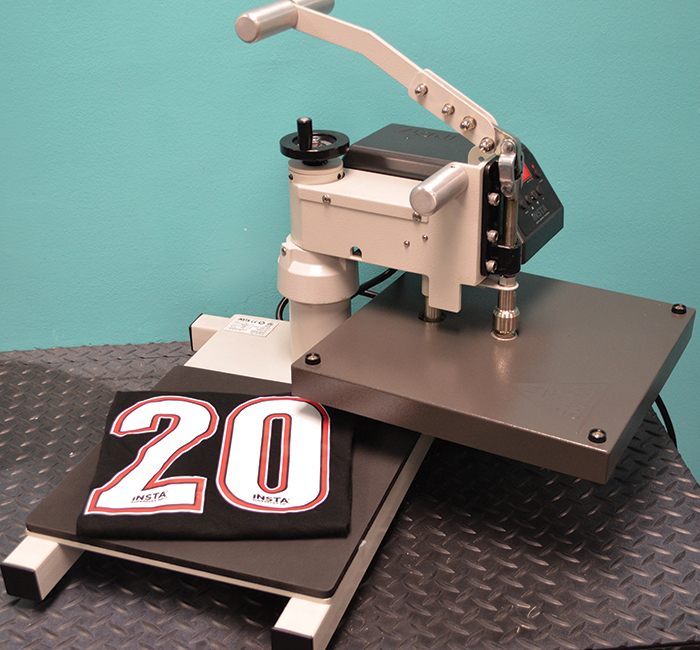The athletic, team sports and uniform markets have grown rapidly during the past several years. Soccer, basketball, football and baseball are a few team sports that are leading the charge at all levels — from organized-sports groups to collegiate teams and professional leagues.
What is really involved in decorating garments for team sports? Take into consideration orders for school teams or other organized-sports groups, which typically are small and complicated. The order may comprise different shirt sizes with specific numbering needs to be applied to different sizes for personalization. Setting up a screen-printing job for each personalized shirt is daunting and time consuming.
Is there a better solution?
Heat transfers allow numbers and letters to be printed in multiples and used from stock inventory as needed. With a quality heat press, transfers easily can be applied to the garments in seconds. Let’s first discuss some basic types of transfers.
Digital Transfers
Digitally printing number or letter transfers, which has become increasingly popular, requires a printer/cutter and special paper. Otherwise, the numbers and transfers must be cut by hand. Such machines can be pricey depending on the size and paper costs.
The downside? Be prepared to spend time weeding and peeling individual numbers and letters once they have been cut. This is no easy task when the order is a rush or the lettering is intricate.
CAD-cut vinyl is another solution used by many decorators. However, it requires investing in a CAD-cut machine and rolls of vinyl to keep in stock. With this transfer type, time spent weeding and peeling also is a consideration.
Pre-Printed Transfers
A pre-printed number or letter transfer is an ideal solution for saving time and money. Unless you have the knowledge and equipment to print your own transfers, custom or stock numbers and letters can be purchased from a vendor. These pre-made transfers are cost effective and come in single or multiple colors and fonts. The transfer can be applied immediately to various types of sports apparel quickly, cleanly and efficiently.
Fabrics
Some of the most popular synthetic fabrics, such as polyester, spandex, Lycra, rayon, nylon, acrylic and viscose, are designed to outperform natural ones in certain cases and have become adept at imitating their natural counterparts. Natural-fabric clothing is produced from fibers taken from cotton, bamboo, leather, linen, hemp, wool and silk.
As the name implies, such fabrics are produced from plants and animals. They can be used as a component blend with other materials to create fabric strength, softness and durability. The fibers are extracted from a natural source and then, through a woven or threaded process, manufactured into a textile.
Heat Presses
A quality, durable heat press is needed to apply any of the aforementioned transfers. Investing in such a machine can save thousands of dollars over time. Ensure your machine has the proper safety certifications offered by Underwriters Laboratories (UL) and Electrical Testing Laboratories (ETL), two nationally recognized testing organizations that are recognized by the Occupational Safety and Health Administration (OSHA). These certifications mean the products have been tested by a third party for safety. Without such certifications, basic safety issues may arise that can result in injury or property damage.
Not all heat presses are created equal, so look for brands with a reputation for even temperature and pressure distribution across the entire platen. Purchasing a mediocre heat press can cause production problems, such as transfers peeling off entirely or in parts, especially after being laundered only once or twice. It’s not worth risking your shop’s reputation or having to pay restitution because the heat-transfer machine didn’t do its job.
There are many types of heat presses. Many users prefer a swing-away press, where the upper platen can be turned 180 degrees, offering an unobstructed view of the entire lower platen and enabling the user to lay transfers across the entire print area. The clamshell press features an upper platen that moves up and down over the lower platen for pressing. More specialized presses that accommodate caps or labels also are available.
Another consideration when choosing a heat press is whether to invest in a manual or automatic model. The automatic version opens and closes at the press of a button. Although pricier than the manual option, it speeds production, and saves time and physical exertion. Some manufacturers also offer accessories that can further simplify the transfer process. Special platens that can accommodate buttons, zippers, panels or pockets can be purchased separately.
Heat transfers’ versatility enables apparel decorators to apply personalized numbers or letters to various garment types and sizes with ease and speed. Transfers are collectively recognized as a durable, convenient and efficient way to apply numbers, letters, logos and other decorations to multiple areas of a finished garment.
Cris Saunders, director of sales and marketing for Insta Graphic Systems, has more than three decades of experience in the decorated-apparel industry. Formerly with Printronix, she has held various positions with Insta and currently oversees machine marketing and worldwide sales. For more information, email [email protected].





